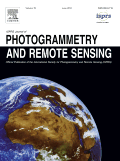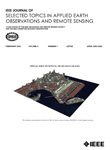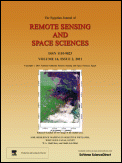
Journal of Applied Remote Sensing
metrics 2024
Exploring the Future of Earth Observation
Introduction
Journal of Applied Remote Sensing, published by SPIE-SOC PHOTO-OPTICAL INSTRUMENTATION ENGINEERS, stands at the forefront of research in the interdisciplinary field of applied remote sensing, focusing on innovative applications and advancements in technology that support our understanding of the Earth's systems. Established in 2007, this journal has quickly gained recognition, currently holding a Q2 ranking in the Earth and Planetary Sciences category, reflecting its influence and quality within the academic community, with a Scopus ranking of #68 out of 195 in General Earth and Planetary Sciences. The journal provides a robust platform for researchers, professionals, and students to disseminate their findings, ensuring open avenues for knowledge exchange in a field that increasingly impacts environmental monitoring, disaster management, and resource management. With its E-ISSN 1931-3195, the Journal of Applied Remote Sensing remains committed to advancing scholarly communication, fostering innovations that respond to real-world challenges, and enhancing remote sensing applications across diverse sectors. The journal operates from its headquarters in Bellingham, WA, USA, and aims to portray cutting-edge research that enriches the academic literature and informs policy and practice.
Metrics 2024
 -
- 1.40
1.40 1.40
1.40 -
-Metrics History
Rank 2024
IF (Web Of Science)
JCI (Web Of Science)
Quartile History
Similar Journals

ISPRS JOURNAL OF PHOTOGRAMMETRY AND REMOTE SENSING
Transforming Data into Knowledge in Geospatial SciencesISPRS Journal of Photogrammetry and Remote Sensing is a prestigious publication at the forefront of the fields of photogrammetry and remote sensing. Established in 1989 and published by Elsevier, this journal has consistently maintained a strong academic standing, currently holding a top-tier Q1 ranking across multiple categories, including Atomic and Molecular Physics, Computer Science Applications, and Engineering. This reflects its vital contribution to advancing knowledge and technology in these dynamic fields. The journal is not only a vital resource for researchers and professionals but also serves as an essential academic platform for students keen on delving into the latest developments in geospatial sciences. The journal operates under a non-open access model, ensuring that submitted research adheres to the highest standards of scholarly communication and integrity. With an impactful focus, it brings innovative research, comprehensive reviews, and significant case studies to a global audience. The ISPRS Journal is crucial for those aiming to enhance their understanding and application of remote sensing techniques within various scientific disciplines.

IEEE Journal of Selected Topics in Applied Earth Observations and Remote Sensing
Bridging Knowledge and Technology in Earth Sciences.IEEE Journal of Selected Topics in Applied Earth Observations and Remote Sensing is a premier peer-reviewed journal published by the IEEE-INST ELECTRICAL ELECTRONICS ENGINEERS INC, focused on advancing the field of Earth observation and remote sensing technologies. With an impressive impact factor, this journal ranks in the top quartile (Q1) for both Atmospheric Science and Computers in Earth Sciences, underscoring its significance and influence in the academic community. Open access since 2020, it facilitates broader dissemination of research findings to enhance global visibility and accessibility for researchers, professionals, and students alike. Spanning the years from 2008 to 2024, the journal covers a myriad of topics that highlight innovative applications of remote sensing data and technologies in addressing environmental challenges. With a Scopus ranking placing it in the 91st and 89th percentiles, respectively, in its categories, the journal serves as a vital resource for advancing scholarly discourse and collaboration in Earth sciences.

Journal of Geovisualization and Spatial Analysis
Charting New Territories in Spatial AnalysisJournal of Geovisualization and Spatial Analysis, published by SpringerNature, is an influential open-access journal specializing in the cutting-edge fields of geovisualization, spatial analysis, and their application in earth sciences and geography. Since its inception in 2017, this journal has established a prominent stance with a high impact factor and prestigious Q1 rankings across multiple categories, including Computers in Earth Sciences, Earth and Planetary Sciences (miscellaneous), and Geography, Planning and Development. The editorial board is committed to advancing innovative research and methodologies, providing a platform for scholars to disseminate their findings globally. With impressive Scopus rankings—placing it in the top percentiles among its peers—the journal serves as a vital resource for researchers, professionals, and students keen on understanding spatial data and its implications for geographic science. Its emphasis on rigorous peer review and rapid publication enhances accessibility to substantive research, thus fostering knowledge sharing within the scientific community. Based in Switzerland, the journal promotes a collaborative environment for interdisciplinary studies, making it an essential read for anyone involved in spatial analysis research.

International Journal of Applied Earth Observation and Geoinformation
Transforming Earth Observation into Actionable Insights.International Journal of Applied Earth Observation and Geoinformation is a premier peer-reviewed journal published by Elsevier, focusing on the integration and application of earth observation and geoinformation technologies across diverse fields. With an open access model established in 2020, this journal enhances accessibility and dissemination of research crucial for addressing global challenges related to climate change, resource management, and sustainable development. The journal occupies a notable position within the academic community, featuring a Q1 ranking in multiple categories including Computers in Earth Sciences, Earth-Surface Processes, and Global and Planetary Change, reflecting its significant impact and relevance in these disciplines. It is recognized for its high-quality articles that explore innovative methodologies and applications, making it an essential resource for researchers, practitioners, and students alike who seek to advance their understanding of earth dynamics and geospatial technology. The journal is indexed in Scopus with impressive rankings that underscore its high citation impact and scholarly influence, with an emphasis on providing a platform for the latest findings in management, monitoring, and policy in environmental science.

Remote Sensing Letters
Exploring the Intersection of Science and EngineeringRemote Sensing Letters, published by Taylor & Francis Ltd, is a distinguished journal that serves a vital role in the fields of Earth and Planetary Sciences as well as Electrical and Electronic Engineering. With an ISSN of 2150-704X and an E-ISSN of 2150-7058, this journal has been disseminating cutting-edge research since its inception in 2010, converging toward a future of innovation and technological advancement scheduled through 2024. The journal is recognized for its impactful scholarship, achieving a Q2 quartile ranking in both its categories as of 2023, highlighting its significance in enhancing academic discourse and applications in remote sensing methodologies. Although it does not operate under an open-access model, it provides access to essential findings that address contemporary challenges in the remote sensing domain. Located in the United Kingdom at 2-4 Park Square, Milton Park, Abingdon, OX14 4RN, Remote Sensing Letters is a crucial resource for researchers, professionals, and students committed to advancing their understanding and application of remote sensing technologies.

Journal of Remote Sensing
Transforming Earth Observation through Innovative ResearchThe Journal of Remote Sensing is a leading scholarly publication dedicated to advancing knowledge and research in the field of remote sensing. Published by the American Association for the Advancement of Science, this open-access journal, which has been available since 2021, strives to provide an inclusive platform for researchers, professionals, and students alike to share transformative findings and innovative techniques related to Earth and planetary sciences, as well as their applications in social sciences and geography. With impressive Scopus rankings, placing it in the 94th percentile for Earth and planetary sciences and the 93rd percentile in geography, the journal is recognized for its high-impact contributions to the field. Researchers can access invaluable content without barriers, ensuring that the latest advancements in remote sensing technology and methodologies are widely disseminated and utilized. By fostering interdisciplinary collaboration and promoting high-caliber research, the Journal of Remote Sensing is becoming an essential resource for anyone interested in the intersection of technology and environmental studies.

IEEE Geoscience and Remote Sensing Letters
Connecting Research and Technology in Earth SciencesIEEE Geoscience and Remote Sensing Letters is a distinguished journal published by the IEEE-INST ELECTRICAL ELECTRONICS ENGINEERS INC, focusing on the cutting-edge realms of geoscience and remote sensing. Since its inception in 2004, the journal has maintained a significant role within its field, achieving a robust impact factor that places it in the Q1 category for both Electrical and Electronic Engineering and Geotechnical Engineering and Engineering Geology, reflecting its high-quality research output and influence. The journal is highly ranked in Scopus, securing the 35th position in Earth and Planetary Sciences and the 154th position in Engineering, showcasing its broad academic reach and engagement with current advancements in technology and earth sciences. Although the journal is not open access, it remains accessible to a wide readership, fostering an environment for innovation and knowledge sharing among researchers, professionals, and students interested in remote sensing technologies and geosciences. With its objective to publish concise articles that present significant results and advancements, IEEE Geoscience and Remote Sensing Letters continues to be a vital resource for anyone engaged in these dynamic fields.

Egyptian Journal of Remote Sensing and Space Sciences
Pioneering Research for a Deeper Understanding of Our UniverseThe Egyptian Journal of Remote Sensing and Space Sciences, published by Elsevier, is a premier open-access journal dedicated to advancing the fields of Remote Sensing and Space Sciences. Since its inception, the journal has gained a prominent reputation, currently holding a prestigious Q1 ranking in Earth and Planetary Sciences and placing within the top 10% of its field according to Scopus metrics. With an ISSN of 1110-9823 and an E-ISSN of 2090-2476, the journal features a diverse range of scholarly articles that explore both theoretical and practical aspects of remote sensing technologies and space science innovations, thus appealing to researchers, professionals, and students alike. Established in 2003 and fully transitioning to an open-access model in 2010, the journal aims to disseminate knowledge and foster collaboration across the globe by providing wider accessibility to groundbreaking research findings. Its commitment to quality and innovation is a catalyst for intellectual development in these dynamic and evolving disciplines.

Revista de Teledeteccion
Bridging theory and practice in Earth sciences.Revista de Teledeteccion, published by UNIV POLITECNICA VALENCIA, EDITORIAL UPV, is a leading Open Access journal dedicated to the interdisciplinary field of remote sensing and its applications. Since its inception in 2010, this journal has provided a vital platform for researchers, professionals, and students to disseminate groundbreaking findings, foster collaboration, and engage with contemporary challenges in Earth and Planetary Sciences as well as Geography, Planning, and Development. With a Q3 ranking in both fields as of 2023, it serves as an essential resource for advancing knowledge and innovative practices in hi-tech remote sensing methodologies. The journal covers a broad spectrum of topics, from satellite imaging techniques to environmental monitoring, making it an invaluable asset for those interested in harnessing remote sensing technologies to address real-world issues. The editorial office is located in Valencia, Spain, and the journal aims to bridge the gap between theoretical research and practical application, enriching the scientific community's understanding and capabilities in this dynamic domain.

Remote Sensing in Ecology and Conservation
Advancing ecological insights through cutting-edge technology.Remote Sensing in Ecology and Conservation is a pioneering journal published by WILEY that has been a beacon of open-access research since 2015. With an E-ISSN of 2056-3485, this journal stands at the forefront of the intersection between ecological research and technological innovation. It is recognized for its significant impact, boasting Q1 rankings across several prestigious categories in 2023, including Computers in Earth Sciences and Ecology, emphasizing its commitment to high-quality, influential scholarship. The journal provides a platform for researchers and practitioners to share their findings in remote sensing applications that advance ecological conservation efforts. Encompassing a broad scope that includes studies on landscape changes, biodiversity assessments, and environmental monitoring, it serves as an essential resource for education and practice in the field. With impressive ranks in Scopus, including a remarkable 6th place in Earth and Planetary Sciences, it continues to shape the dialogue in ecology and conservation. As an open-access journal, it champions the dissemination of knowledge, making critical research accessible to a global audience, thereby fostering innovation and collaboration in the pursuit of sustainable environmental practices.